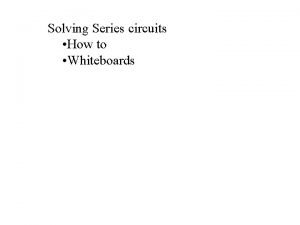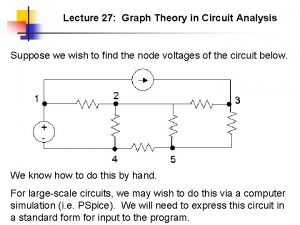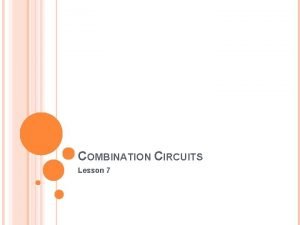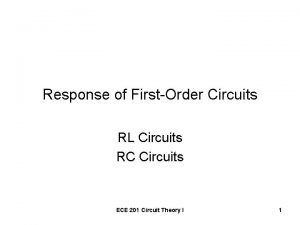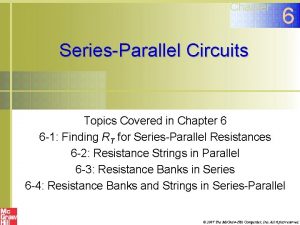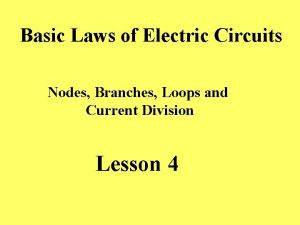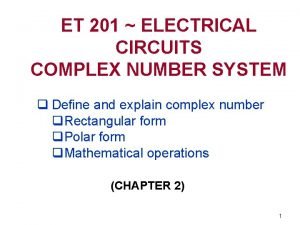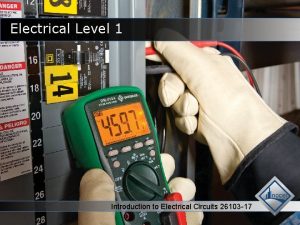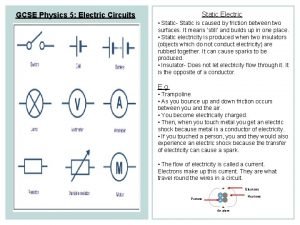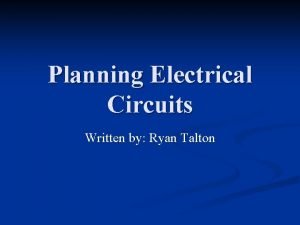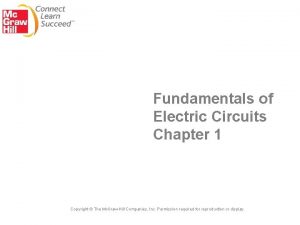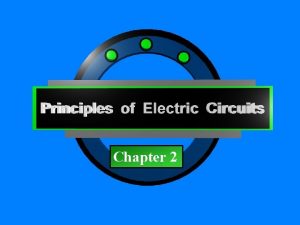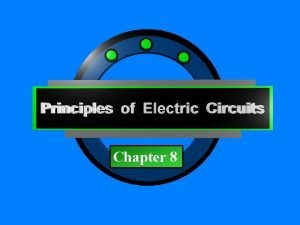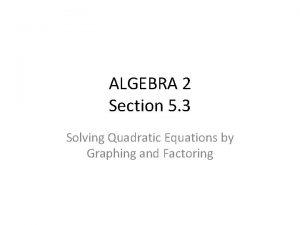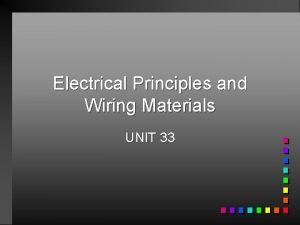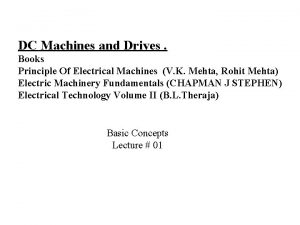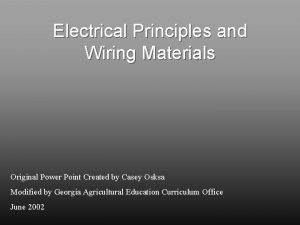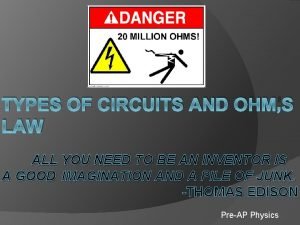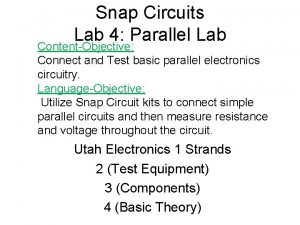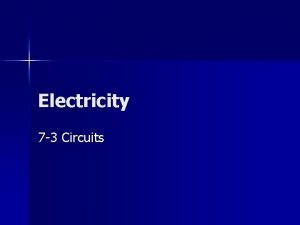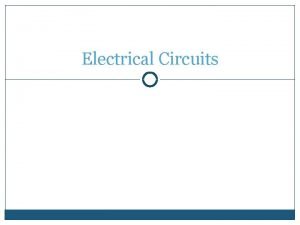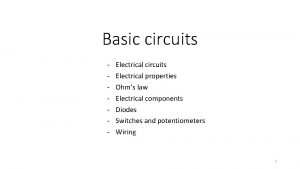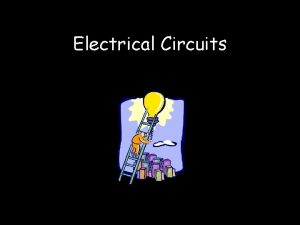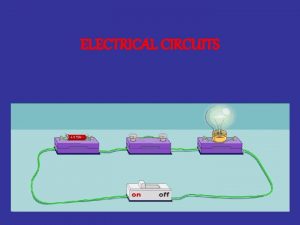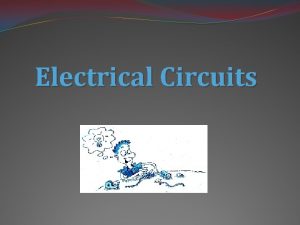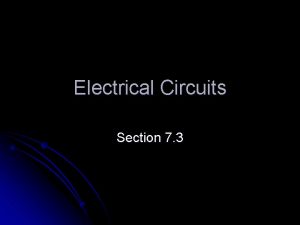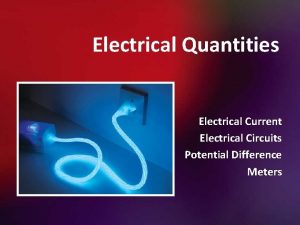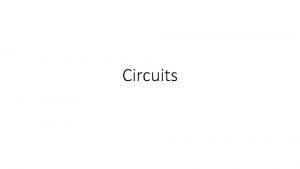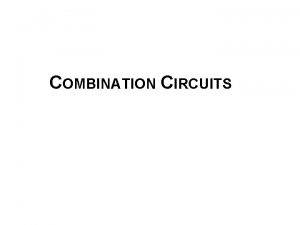Electrical Principles Topic 4 Solving AC Electrical Circuits































- Slides: 31

Electrical Principles Topic 4: Solving AC Electrical Circuits All copyright and intellectual property rights in respect of materials developed by the service provider during this project will vest in the Department of Higher Education and Training, which will have the right to allow any individual, company, agency or organisation to use or modify the materials for any purpose approved by this Department, including selling the materials or releasing them as Open Educational Resources (OER) under an appropriate copyright license.

Assumed prior learning 05_01_00 05_01_02 05_02_01 05_03_01 05_04_01

Outcomes By the end of this unit the learner will be able to: 1. Calculate resistance, inductive reactance, impedance, voltage, current, power factor and frequency in a series RL circuit. 2. Construct a phasor diagram to represent the relationship between the voltage and current in a series RL circuit.

Unit 4. 4: Series RL Circuits

Introduction In the previous unit we learnt about how inductors and capacitors oppose the flow of current in AC circuits. This opposition is called reactance. In this unit, we are going to look at how circuits with resistors and inductors in them behave.

Series RL circuits We know that series circuits have all the components connected end to end so that there is only one path for the current. Let’s investigate what happens when we have a resistor and an inductor together in a series circuit. Download and work through the worksheet. Then watch the video Vid 01 to make sure you completed everything correctly. Download the worksheet

Series RL Circuits In series AC circuits where there are resistors and inductors, we need to take account of the fact that the voltage across the inductor leads the current through the inductor by 90° when doing calculations. The voltage across and current through the resistor are in phase. A series RL circuit VR IT VL V and I waveforms

Total voltage in a series RL circuit The total voltage drop in a series RL circuit is the vector sum of the voltage drops across the resistor and the inductor. Remember that Kirchoff’s Voltage Law does not work. VL 90° VT θ θ IT Phasor Diagram VR 0°

Total impedance in series RL circuits The combined resistance to the flow of current from resistance and reactance is called impedance (Z). It is measured in Ω. The total impedance in a series RL circuit is the vector sum of the resistance and inductive reactance. VT (Z) VL (XL) θ Phasor Diagram VR (R)

The phase angle in series RL circuits There are many ways to calculate the phase angle (θ) in a series RC circuit. VT θ VL 90° VT (Z) VL (XL) θ θ VR (R) VR 0°

Power in series RL circuits The current in this circuit lags the voltage by the phase angle, θ, because of the inductor. Therefore the circuit has a lagging power factor. P = true power (W) VT = total voltage (V) IT = total current (A) θ = phase angle (°)

Solving series RL circuits – example 1 Let’s start with this example. 110 V Redraw the circuit on a blank piece of paper. In this circuit, calculate the: 1. Impedance; 2. Voltage drop across each component; 3. Phase angle; and 4. Draw the phasor diagram.

Solving series RL circuits – step 1 Once you have drawn the basic circuit, you need to label it. When dealing with series RL circuits, it is important that you label it correctly. This will help later on. Remember that this is still a series circuit so IT = IR = IL. IT R = L = IR IL VR VL VT = 110 V

Solving series RL circuits – step 2 Now we can start answering the questions. Calculate the total impedance in the circuit. Enter your answer to three decimal places. IT R = L = IR IL VR VL VT = 110 V Ω Check

Solving series RL circuits – step 2 Calculate the voltage drop across each component. Enter your answers to three decimal places. IT VR V VL V R = L = IR IL VR VL VT = 110 V Check

Solving series RL circuits – step 2 Calculate the phase angle. Enter your answer to three decimal places. IT R = L = IR IL VR VL VT = 110 V θ Check

Solving series RL circuits – step 2 Draw the phasor diagram for this circuit on a piece of paper then take a photo of it and upload it to your online portfolio. Choose image Upload

Solving series RL circuits - solution Watch the video to see the full worked solution for this question. You can also have a look at a simulation of the circuit. Full worked solution See the circuit simulation IT R = L = IR IL VR VL VT = 110 V

Solving series RL circuits – example 2 In this circuit, calculate the: 1. Impedance 2. Total current; 3. The voltage drop across the inductor; 4. True power; 5. Power factor; and 6. Draw the phasor diagram 9. 5 V Try the question on your own and then watch the full worked solution. Circuit simulation Full worked solution

Document Briefing – Doc 01 (1 of 2) Create an annotated PDF worksheet with the following steps. • Make sure you have downloaded the Every. Circuit App from your app store. • If you are working on a computer, visit http: //everycircuit. com/app/. • Open the Every. Circuit app and signup. After your trial, you will still have access to Every. Circuit and other people’s circuits. You will just not be able to create your own circuits. • Go to the community space and search for the circuit called “NOC_Series RL Circuit” • Open the circuit. • This circuit has an AC power supply with a frequency of 1 k. Hz (or 1 000 cycles per second) and a peak voltage of 9 V. It also has a 470Ω and a 12 m. H inductor. • Click on the ammeter to find out what its reading is. Is this the same current through the resistor and the inductor? Why or why not? • We know that the inductance (XL) of an inductor is given by 2πf. L. Calculate XL. • Now calculate the voltage across the inductor, VL.

Document Briefing – Doc 01 (2 of 2) • Click on the voltmeters across the indictor and resistor to check your answers. • What is the total voltage supplied by the power source (VT)? Does Kirchoff’s voltage Law hold? In other words, does VT = VR + VL? • We have discovered that Kirchoff’s Voltage Law does not work in this circuit because we cannot just add the voltage drops across the components to find the total voltage drop across the whole circuit. • We know that the total voltage drop across the whole circuit is 9 V. Use this and the circuit current to calculate the total resistance in the circuit, RT. • Does RT = R + XL? • We have discovered that we cannot just sum the resistance of the resistor and reactance of the inductor to find the total opposition to current in the circuit.

Video Briefing – Vid 01 (1 of 2) Create a screencast video presented by an expert presenter. The presenter needs to work through the Doc 01 worksheet and cover and explain the following steps. • Opening the app and opening the circuit for mobile and desktop • Calculate XL, VL and VR. • Check that VL and VR are the same as the voltmeter readings in the simulation. • Show that KVL does not hold. • From IT and VT, calculate RT (for now just a placeholder for Z) • Show that RT does not equal R + XL. • Remind learners that the voltage across the indictor leads the current by 90° but that the voltage across the resistor is in phase with the current (show this in the simulation). • Draw the phasors for VR and VL with respect to the current or VT. • Use (in phase) and (out of phase) nomenclature.

Video Briefing – Vid 01 (2 of 2)

Video Briefing – Vid 02 (1 of 3) Create a screencast video presented by an expert presenter. The presenter needs to work through the question in example 1. In this circuit, calculate the: 1. Impedance 2. Voltage drop across each component 3. Phase angle 4. Draw the phasor diagram 110 V

Video Briefing – Vid 02 (2 of 3)

Video Briefing – Vid 02 (3 of 3)

Video Briefing – Vid 03 (1 of 5) Create a screencast video presented by an expert presenter. The presenter needs to work through the question in example 2. In this circuit, calculate the: 1. Impedance 2. Total current; 3. The voltage drop across the inductor; and 4. True power in the circuit. 9. 5 V

Video Briefing – Vid 03 (2 of 5) Redraw and label the circuit as follows. Note that IT = IR 1 = IR 2 = IL R 1 = IT VR 1 VT = 9. 5 V VL L = R 2 = VR 2

Video Briefing – Vid 03 (3 of 5)

Video Briefing – Vid 03 (4 of 5) Question 4: True power P = VIcosθ. But sinθ = VL / VT = 1. 232 V / 9. 5 V. Therefore θ = 7. 451° So P = 9. 5 V x 0. 0051056 x cos(7. 451) = 0. 04809 W = 48. 093 m. W Question 5: Power factor = cosθ = cos 7. 451° = 0. 992

Video Briefing – Vid 03 (5 of 5) Question 6: Z = 1860. 710Ω XL = 241. 274Ω Draw the phasor with impedance as XL and RT were known. Had not worked out voltage drop across both resistors. 7. 451° RT = 1845Ω
 Advantages of parallel circuits over series circuits
Advantages of parallel circuits over series circuits Solving series circuits
Solving series circuits Circuit analysis
Circuit analysis Calculating combination circuits
Calculating combination circuits Circuit theory
Circuit theory Solving parallel circuits
Solving parallel circuits Types of circuit
Types of circuit What is a node in electrical circuits
What is a node in electrical circuits Complex numbers in electrical circuits
Complex numbers in electrical circuits Nccer introduction to electrical circuits
Nccer introduction to electrical circuits Electrical circuits gcse
Electrical circuits gcse Planning electrical circuits
Planning electrical circuits Copyright
Copyright Clincher sentence
Clincher sentence Narrowing down a topic exercises
Narrowing down a topic exercises Principles of electric circuits
Principles of electric circuits Principles of electric circuits 10th edition answer key
Principles of electric circuits 10th edition answer key Section 5 topic 3 solving quadratic equations by factoring
Section 5 topic 3 solving quadratic equations by factoring Topic 9 solving quadratic equations
Topic 9 solving quadratic equations Section 5 topic 3 solving quadratic equations by factoring
Section 5 topic 3 solving quadratic equations by factoring Unit 33 electrical principles and wiring materials
Unit 33 electrical principles and wiring materials Principles of electrical machines vk mehta
Principles of electrical machines vk mehta Principles and applications of electrical engineering
Principles and applications of electrical engineering Principles and applications of electrical engineering
Principles and applications of electrical engineering Unit 33 electrical principles and wiring materials
Unit 33 electrical principles and wiring materials Lesson outline lesson 3 describing circuits answers
Lesson outline lesson 3 describing circuits answers Datagram network vs virtual circuit network
Datagram network vs virtual circuit network Types of circuits and ohm's law answer key
Types of circuits and ohm's law answer key Spinal cord
Spinal cord Op amp isolation circuit
Op amp isolation circuit Snap circuits project lab
Snap circuits project lab Circuit in parallel vs series
Circuit in parallel vs series

